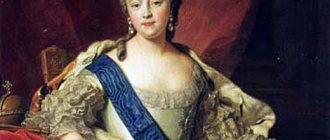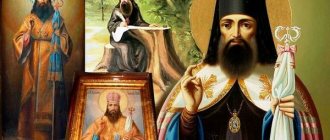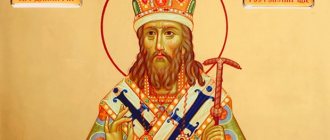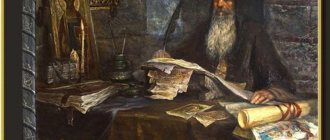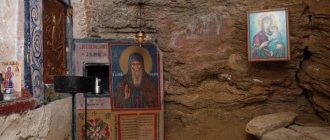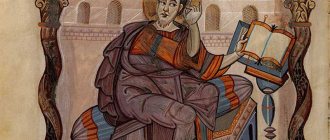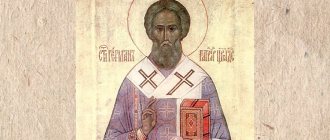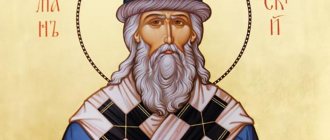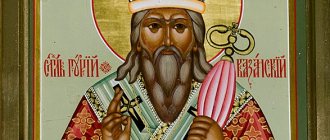| St. Barsanuphius of Kazan |
Barsanuphius of Kazan
(c. 1495 - 1576), Bishop of Tver, miracle worker, saint Commemorated April 11, October 4 for the transfer of relics [1], in the Cathedrals of Kazan and Tver Saints
In the world, John was born around 1495 in the city of Serpukhov in the family of the priest Vasily. Distinguished by his hard work and understanding, the youth easily mastered reading and writing, mastered reading the Psalter and church singing to such an extent that he could not only read and sing himself, but also help others.
In May 1512, the Crimean Horde, led by princes Akhmat and Burnash, sons of Khan Mengli-Girey, attacked Serpukhov and Varsanuphius, a seventeen-year-old youth, was captured. He was taken to Crimea and sold into slavery. In severe trials he had to endure a lot, but, trusting in the Lord, the future saint lived as a novice in a monastery, learning obedience, kindness and patience. He slept and ate little, was distinguished by his zeal and meekness, worked without contradiction, and therefore won over the hardened hearts of the Gentiles. Gradually, he mastered the spoken Tatar language to such an extent that after two years he could not only speak well, but also write in Tatar.
The captivity lasted three years. With great difficulty, having collected the necessary amount, priest Vasily ransomed his son from there. Blessed John returned home. According to the unshakable decision that matured in the soul of the young man while still in captivity, he went to Moscow, where he took monastic vows at the Spassky Andronikov Monastery, making vows of virginity, obedience and non-covetousness to God. The newly tonsured monk was named Barsanuphius.
With a strict and godly life, he succeeded in deeds of virtue and prayer. At the monastery he met Saint Akakios, Bishop of Tver, who predicted that Barsanuphius would be his successor at the see.
In 1544, with the blessing of Metropolitan Macarius of Moscow, he was installed as abbot of the Nikolsky Pesnoshsky Monastery.
In 1553, on the way to the Kirillov Monastery, the Pesnosh monastery was visited by Tsar John Vasilyevich, who drew attention to the experienced abbot, an expert in the Tatar language and customs. In 1555, elevated to the rank of archimandrite, together with the saints Archbishop Gury and Archimandrite Herman, he was sent to the newly established Kazan diocese to found a monastery. On July 31 (or 27) of the same year he arrived in Kazan together with the monks of the Pesnosha Monastery Tikhon, Theodorit, Job, Andronik and Sylvester, as well as the monk of the Andronikov Monastery Simeon. With the help of the sovereign, around 1557 the brethren founded the Kazan Transfiguration Monastery. Soon, Archimandrite Barsanuphius consecrated the first monastery church - St. Nicholas, and a little later - the Transfiguration Cathedral. The monastery was equipped with extensive estates and grew rapidly, being organized according to the charter drawn up by Barsanuphius [2]. Thanks to his knowledge of Tatar, Barsanuphius zealously preached the Gospel to the Tatars. The saint wore chains secretly from everyone. Thanks to his ability to heal mental and physical illnesses, his name became known far beyond the borders of Kazan; many sick people who came to him for healing converted to Christianity. On December 2, 1563, he was tonsured into the great schema, and on December 5, he performed the funeral service for St. Gury of Kazan.
In 1567, Saint Philip, Metropolitan of Moscow, summoned Saint Barsanuphius to Moscow and consecrated him Bishop of Tver and Kashin. In the same year he consecrated the Ascension Church in the Orshina Monastery. Despite his episcopal rank, he remained the humble ascetic he had been before. He spent his days in labor, his nights in prayer, while resting he sewed hoods, which he gave to monks and bishops. With unceasing prayer he healed the physical and mental illnesses of those who turned to him.
His priesthood in Tver occurred during the troubled years of the oprichnina. In 1569, Saint Philip, languishing in prison on the Tver land, in the Otroch Monastery, was deprived of his life by Malyuta Skuratov. Saint Barsanuphius was not allowed to know about his death and the body of Saint Philip was buried in the presence of Malyuta.
Dejected by old age and physical ailments, he retired in 1570 and returned to the Kazan Transfiguration Monastery, which he founded, where he died on April 11, 1576 [3]. The saint was buried by Kazan Archbishop Tikhon at the altar of the Transfiguration Cathedral, next to St. Gury.
Reverence
On October 4, 1595, in preparation for the construction of a new church at the Transfiguration Monastery, the relics of Saints Gurias and Barsanuphius were found incorrupt, and their tombs were full of fragrant myrrh. When the tombs were opened, those suffering from various diseases and possessed by an unclean spirit received quick healing. At the same time, the Kazan enlighteners were glorified by decree of the first Patriarch of Moscow, St. Job. By order of the saints Tsar Theodore Ioannovich and Patriarch Job, the lives of Saints Gurias and Barsanuphius were compiled by the Kazan Metropolitan and future Patriarch Hieromartyr Hermogenes, who knew Barsanuphius well when he was a priest, and then witnessed the miraculous incorruption and aroma of his relics [4].
Soon, a southern chapel was added to the cathedral church of the Transfiguration Monastery in the name of Saints Gurias and Barsanuphius, and the relics of the saints were placed in it, in appropriate arks, one next to the other. On June 20, 1630, by order of Metropolitan Matthew, who then ruled the Kazan diocese, the relics of St. Barsanuphius were placed on the right side between the pillars of the main church. During the fire of 1694, the relics were damaged by fire, after which they were placed in a silver shrine in the same place. The service to Saints Gurias and Barsanuphius was compiled by the Rostov Metropolitan Saint Demetrius.
The relics of the saint rested in the same place until 1918. In September of that year, after the closure of the monastery, they were moved to the Cathedral of the Mother of God Convent. Then the relics of Saint Barsanuphius were placed in the Central Historical Museum of the TASSR, where they were kept in the basements. In the 1980s, during the next subbotnik, the relics were destroyed; Only a silver shrine has survived. Subsequently, it was put on public display at the Central Historical Museum of the Republic of Tatarstan. A small particle of the relics of St. Barsanuphius was preserved in the icon of the three saints of Kazan, which is located in the cemetery church of the Yaroslavl Wonderworkers in the city of Kazan, above the shrine with the relics of St. Gury of Kazan.
Saint Barsanuphius of Tver, bishop
Saint Barsanuphius, Bishop of Tver, wonderworker of Kazan, was born around 1495 in the city of Serpukhov in the family of priest Vasily. At Baptism, the baby received the name John. Distinguished by his hard work and understanding, the youth easily mastered reading and writing, mastered reading the Psalter and church singing to such an extent that he could not only read and sing himself, but also help others.
In 1512, the Crimean Tatars, led by Akhmat Giray and Burnat Giray, went on a campaign against Ryazan, but “having failed to capture the city of Ryazan,” they carried out a quick and unexpected devastating raid along the banks of the Oka. Among many, John, a seventeen-year-old youth, was taken into captivity. The young man had to endure a lot in captivity, but in severe trials the faith of Christ, deeply rooted in his heart even in his parents’ home, bore fruit a hundredfold. Trusting in the Lord, the future saint prayed and sang psalms that came to mind, and lived like a novice lives in a monastery, quietly learning obedience, kindness and patience. John slept very little, hardly touched food, was distinguished by zeal and meekness, worked without contradiction, and therefore won over even the hardened hearts of the Gentiles, who, unwittingly recognizing his merits, began to treat him softer and more condescending than others.
Gradually, thanks to his extraordinary abilities, he mastered the spoken Tatar language to such an extent that after two years he could not only speak well, but also write in Tatar. The captivity lasted three years. With great difficulty, having collected the necessary amount, priest Vasily ransomed his son John from Tatar captivity. Blessed John returned home, but his heart had already cooled forever to the fickle earthly joys and pleasures. According to the unshakable decision that matured in the soul of the young man while still in captivity, he went to Moscow, where in the Spassky Andronikov Monastery he took monastic vows, giving God vows of virginity, obedience and non-covetousness. The newly tonsured monk was named Barsanuphius.
With a strict and godly life, the monk Barsanuphius succeeded in deeds of virtue and prayer. Saint Akakios, Bishop of Tver (1522–1567), the younger brother of St. Joseph of Volotsk and tonsure of the Joseph-Volokolamsk Monastery, a kind and pious archpastor, awarded by God the gift of clairvoyance, visited the Andronikov Monastery. He repeatedly predicted to the Monk Barsanuphius, who was still in the rank of hierodeacon, that it was he who would one day become the successor of Saint Akakios at the Tver See. The virtuous and pious life of St. Barsanuphius became known to Metropolitan Macarius of Moscow, who elevated St. Barsanuphius to the rank of abbot of the Nikolo-Peshnoshskaya Methodius Hermitage, founded in 1461 by the disciple of St. Sergius of Radonezh, St. Methodius (June 14) 15 versts from Dmitrov. In the old days this desert was called “Nikola on Pesnusha”.
In 1553, on a pilgrimage (in gratitude for the miraculous deliverance from death), on the way to the Kirillov Belozersky Monastery, Tsar Ivan the Terrible and his family visited the Peshnosha monastery. He drew attention to an experienced mentor of monastic life, who had been in captivity and was knowledgeable in the Tatar language and customs. Therefore, when a new diocese was opened in Kazan in 1555, together with Saint Gury, the first Archbishop of Kazan, Saint Barsanuphius was sent to Kazan from the Peshnosh monastery in the rank of archimandrite to found a monastery there.
On May 26, 1555, the high priests of Kazan solemnly set off on their journey. From Moscow along the Moscow, Oka and Volga rivers, the journey to Kazan lasted two months. On Sunday, July 27, 1555, Saint Gury with the hegumen of Peshnoshsky Barsanuphius and the hegumen of the Assumption Staritsky Monastery Herman arrived in Kazan. They were greeted with crosses and banners in the Kazan Annunciation Cathedral by the local clergy and population. Together with Saint Barsanuphius, the monks who were tonsured by Peshnosha arrived in Kazan: Tikhon, Theodorit, Job, Andronik, Sylvester, as well as the monk of the Andronikov Monastery Simeon. Already in the next year, 1556, the Monk Barsanuphius fulfilled the assignment entrusted to him and built the Transfiguration Monastery in the Kazan Kremlin. He consecrated the first warm stone church in the monastery in the name of St. Nicholas the Ratnoy, and subsequently the main church in honor of the Transfiguration of the Lord.
Secretly from everyone, he continued to wear chains to wear out his flesh. The monastery soon became the center of the spiritual life of the former Tatar capital. A few years later the number of monks in it reached one hundred people. Saint Barsanuphius converted the Tatars to the Orthodox faith, which was greatly facilitated by his excellent knowledge of the Tatar language. Thanks to the healing of various ailments, his name became known far beyond the borders of Kazan. And many sick people who came to him for healing were inclined to accept the Christian faith. After the death of Bishop Akakios of Tver (1567), Saint Philip, Metropolitan of Moscow, summoned Saint Barsanuphius to Moscow and elevated him to the rank of Bishop of Tver.
Saint Barsanuphius was a true lamp for his flock, not with words alone, but with his whole being, pointing out the saving path of Christ. Despite his high priestly rank, he continued to be a humble ascetic, as he was in the Peshnosh monastery and in Kazan. He spent his nights in prayer, his days in work and worries, resting, sewing hoods and giving them to monks and bishops, and with unceasing prayer he diligently healed the physical and mental illnesses of those who turned to him. At that time, difficult trials began for Russia - Tsar Ivan the Terrible, who wisely and piously ruled Russia, became a horror and a scourge for his subjects, instilling the so-called “oprichnina”. Tver did not belong to the oprichnina and therefore did not enjoy the favor of the tsar. With horror and indignation, Saint Barsanuphius saw how his friend German, Archbishop of Kazan (November 6), who had once enjoyed the respect of the tsar, was summoned from Kazan to Moscow to be elevated to the rank of metropolitan, but after he reminded the tsar in quiet and meek words, that he would give an answer at God's court for his cruelties, was expelled and died in captivity. Many terrible events took place before the eyes of Saint Barsanuphius during the four years of his episcopal service. Saint Barsanuphius deeply grieved for his flock. Feeling the infirmity of old age, in 1571 he retired to the monastery he founded in Kazan. He spent five years in the Transfiguration Monastery in peace, prayer and solitude, where he received the great schema. When, due to weakness, he could not go to church himself, loving disciples helped him visit the temple of God, knowing his love for Divine services.
Saint Barsanuphius died on April 11, 1576 and was buried in the Transfiguration Monastery by Archbishop Tikhon of Kazan. In 1595, with the blessing of His Holiness Patriarch Job (1588–1607), a new church was built in this monastery in honor of the Transfiguration of the Lord. During the construction of the temple, the relics of the Kazan saints Guria and Barsanuphius were found.
The biography of Saints Gurias and Barsanuphius was compiled by the Hieromartyr Patriarch Hermogenes.
October 4/17 – Finding of relics
The discovery of the relics of Saint Gury, Archbishop of Kazan († 1563), and Barsanuphius, Bishop of Tver († 1576), took place in Kazan in 1595. During the construction of a new stone church in honor of the Transfiguration of the Lord in the Transfiguration Monastery of the Savior, founded by St. Barsanuphius, coffins with the bodies of the saints were dug up near the altar wall of the former wooden church. The unusual appearance of the incorruptible coffins filled Saint Hermogenes (February 17) with reverent boldness to open the coffins in front of a large crowd of people. Saint Hermogenes himself describes this event as follows: “We saw a miracle, but we did not expect it. The holy cancer is full of the fragrant world, like pure water, but the relics of Saint Guria are at the top of the world like a lip. God grant incorruption to his honest and laborious body, as even now it is visible to everyone. I only touched the decay of my upper lip, but the rest of his lips were intact and unharmed. By touch, his funeral vestments and byakhu are very strong. Then we opened the shrine of St. Barsanuphius and saw: with many incorruptibles, venerate from God the relics of St. Barsanuphius. I touch the saint’s feet with corruption, but not only are the bones not destroyed, but they are very strong and there is no weakness in the composition of the property, just like Saint Guria. And the funeral vestments, like those of the Venerable Gurias, are stronger than the new ones.” Many sick people were healed by being anointed with the holy myrrh that flowed from the relics of St. Gury.
In the Iconographic Original for October 4 it is said: “Guriy, in the likeness of gray-haired, brada, like Basil of Caesarea, in a hat, in an omophorion, in his hands is a Gospel, a saint’s robe. Barsanuphius, in the likeness of a priest, sat on a bridle, like Guriev, at the end of a bifurcated cap, wearing a holy robe, an omophorion and the Gospel.”
In accordance with the report of Archbishop of Cheboksary and Chuvashia Veniamin (Novitsky; † October 14, 1976), His Holiness Patriarch of Moscow and All Rus' Pimen blessed to create a cathedral commemoration for all Kazan saints on the first Sunday after October 4.
See also:
- The Life of Saints Guria, Archbishop of Kazan, and Barsanuphius, Bishop of Tver St. Dimitry Rostovsky
- Lives of St. Saints of Christ Guria, Barsanuphius and Herman, Kazan wonderworkers
- Barsanuphius, Bishop of Tver prof. S.I. Smirnov
- Gury, Archbishop of Kazan and Barsanuphius, Bishop of Tver prof. S.I. Smirnov
- Barsanuphius, Saint, Metropolitan Bishop of Tver. Manuil (Lemeshevsky)
- Venerable Barsanuphius, Bishop of Tver and Kazan Wonderworker, Count M.V. Tolstoy
- Barsanuphius, saint, bishop D.A. Eristov
Documents, literature
- PSRL. T. 4. P. 309; T. 19. M., 2000. Stb. 482; T. 31. M., 1968. S. 141, 146.
- Platon (Lyubarsky), archbishop. Kazan Sat. Art. Kaz., 1868. P. 7-32.
- Hermogenes, Patr. Moscow and all Russia. Creations. M., 1912.
- Barsukov. Sources of hagiography. pp. 141-143.
- Church antiquities of Kazan // Izv. for the Kazan diocese. Kaz., 1877. P. 408-409.
- Nevostruev K. [I.] List from scribe books for the city of Kazan with the district for 1566-1568. Kaz., 1877. P. 31.
- The art of Stroganov masters: Restoration. Research Problem: Cat. vyst. M., 1991. P. 162. No. 108.
- Silkin A.V. Stroganov face sewing. M., 2002. P. 278, No. 88; P. 282, No. 87; P. 296, No. 95; P. 326, No. 129.
- Eliseev G. Z. Biography of St. Guria, Herman and Barsanuphius of Kazan and Sviyazhsk miracle workers. Kaz., 1847.
- [Grigory (Postnikov), archbishop]. Life of St. and Wonderworkers Guria Archbishop. Kazansky and Barsanuphius Archbishop. Tverskoy. St. Petersburg, 1853.
- Stroev. Lists of hierarchs. pp. 216, 442.
- Rudnev V. St. Barsanuphius as abbot of the Nikolaev Pesnosha Monastery. M., 1889.
- [Dimitri (Sambikin), archbishop]. Tver Patericon. Kaz., 1907. P. 81-84.
- Nikanor (Kamensky), archbishop. Life of St. Barsanuphia // Kazan collection. Art. Kaz., 1910.
- Macarius. History of the RC. Book 6. P. 56, 88, 139, 587. Note. 93, 617. Note. 174.
- Lebedev E.M. Spassky Monastery in Kazan. Kaz., 1895.
- Batalov A. L. Mosk. stone architecture XVI century M., 1996. pp. 44-45.
Prayer to Saint Barsanuphius, Bishop of Tver, Wonderworker of Kazan
“Come, Saint Barsanuphius, from the mountain villages to your relics flowing to the race and listen to their prayer: beg the Lord God to grant to all of us what we ask Him for our salvation with your holy relics. Be an intercessor and intercessor for all of us in our needs and petitions. Pray to the Lord God to grant strong and inviolable peace, decorum, enlightenment of minds and hearts, and fruitfulness of the land, holiness to the shepherds, truth and strength to the laws, wisdom and invincible courage to the military commander, justice to the mayor, devotion to the faith and the Fatherland to the army, and invincible courage, to all Orthodox Christian health and piety. Preserve your holy monastery from all the slander of the enemy, so that in word and deed the all-holy Name of the Father and the Son and the Holy Spirit may be glorified in it, now and ever and unto ages of ages. Amen."
